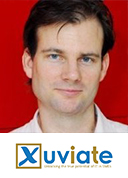INSIGHTS
Xuviate Says IT Transformation ‘Squeezes’ Mid-Sized Firms
IT transformation brings new agility and speed to large companies. Similarly, small startups can leverage cloud-enabled technologies to gain the sort of power and presence once reserved for their biggest rivals. But what’s happening in the middle?
Mid-sized companies are getting squeezed at both ends, according to Mathias Tölken and Mark Geschke, co-founders of Xuviate. The Cape Town, South Africa, company aims to change that by helping companies with about $10 million to $200 million in sales to assess their technology needs through a process called Relevant IT®.
We need to start separating and building out each of the value propositions and through cultural, structural, strategic and operational changes push teams to work with each other.
The process helps IT leaders avoid the trap of being cast as a jack-of-all-trades who “do it all” when it comes to the company’s technology needs. Instead, the Relevant IT® framework matches IT roles with four value propositions (or VPs in short) based on platform, processes, innovation and transformation.
While Geschke allows there are some people who can play many roles in IT, “most people cannot. We’re just driving them to their undoing by asking them to do everything,” he said in a recent interview. “We need to start separating and building out each of the value propositions and through cultural, structural, strategic and operational changes push teams to work with each other.”
Any Relevant IT® journey starts with an assessment provided by a patent-pending online toolset that asks different people within the company to evaluate the performance of IT. This results in a heat map showing the perceptions of IT from different stakeholders based on the four value propositions. The intent is to help the IT leader(s) to identify gaps between business managers and the IT group, and to “systematically address any business technology management issues.”
The first VP focuses on providing a stable and cost-effective platform, which is typically the top priority in any IT group. “The mandate of that role is going to be how to continue providing that platform securely, reliably, cost-effectively, but also in such a way that it becomes flexible,” said Geschke. “The Cloud becomes a big enabler for delivering (results) a lot faster.”
The second VP looks at automating and optimizing business processes. “This is where IT becomes an integral part for other business persons,” he said. “It’s about how they use technology effectively and efficiently to make sure that business practices run better.”
The third VP is about innovation and marketplace differentiation. “That’s about how technology can digitize your business process in a way that you become innovative and create new products for the market,” Geschke explained.
And the fourth centers on a transformation of a company’s business model through technology. “That’s where you really use your entire technology stack and say, ‘What’s the next big thing for my business and industry?,’” he said. “It’s usually where the very tech-savvy CEO gets involved who knows how to pivot from one business model to the next.”
60 Ratings
The initial assessment rates the company on 15 competencies for each of the four value propositions, resulting in a Relevant IT® roadmap that helps IT leaders to focus on their weakest areas as well as strengths.
Geschke and Tölken said that where so many mid-sized companies go wrong is in assuming all four value propositions must be addressed by one IT leader. Tölken said they’re finding that in enterprise the first value proposition is best represented by the CIO, while the second belongs to a Chief Process Officer or a COO. The third, innovation, is best served by a traditional CTO while the fourth falls to the Chief Strategy Officer or the CEO.
Big companies further all the more add a Chief Digital Officer as a transitionary role to enable digital transformation.
“But as you get smaller, you can’t have four dedicated people,” said Tölken. “In smaller businesses, there might be people who are wearing these hats as well as their own. The role of innovation, for example, can be done by an IT-savvy chief marketing officer.”
Xuviate recently released an extensive blog article to explain this approach in more detail.
In the age of transformation, Tölken says, bigger companies are “becoming all the more agile, and they’ve got the money and manpower to throw at the different challenges. The very small ones are also quite savvy, because they are now growing up in this technology world and using cloud as their default”.
“It is the middle enterprise that gets squeezed from both sides,” said Tölken. “They don’t have the money, don’t have the resources. They are often built around a single idea. Twenty years ago, it was easy. You built something and then over the lifetime of the company, it was one single idea that sustained it.”
Not anymore. Today, Tölken said mid-sized companies represent the slowest-moving part of the marketplace. And that’s what Xuviate wants to change.
Contributors

Mark Geschke
CoFounder
Xuviate
Read Biography

Mathias Tölken
CoFounder
Xuviate
Read Biography
More Point of Views

Srini Koushik
Chief Technology OfficerMagellan Health
Point of view story
The Traditional Model of IT is Dead - Meet Exponential IT
Zahl Limbuwala
CEO and Co-FounderRomonet


